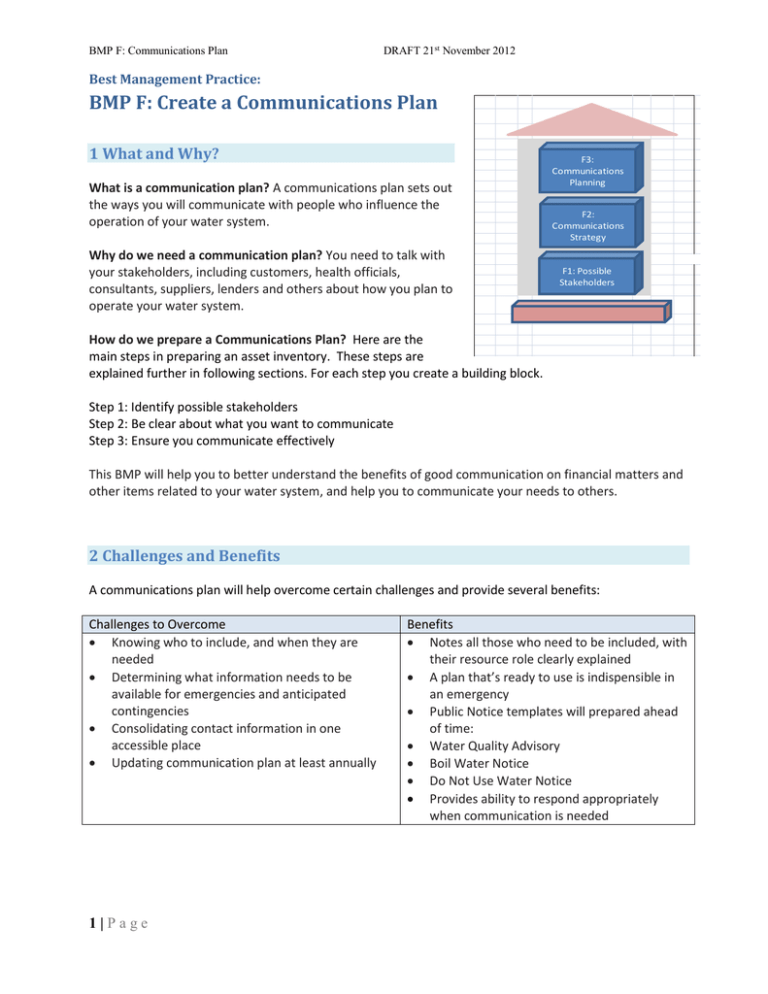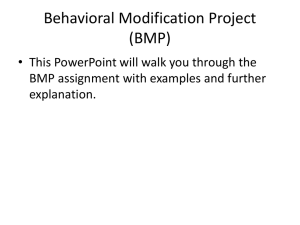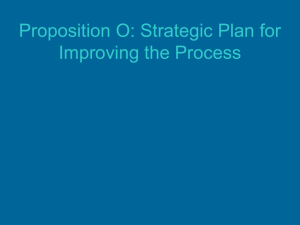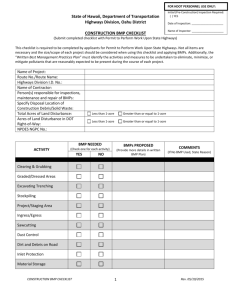1 What and Why?
advertisement

BMP F: Communications Plan DRAFT 21st November 2012 Best Management Practice: BMP F: Create a Communications Plan 1 What and Why? What is a communication plan? A communications plan sets out the ways you will communicate with people who influence the operation of your water system. Why do we need a communication plan? You need to talk with your stakeholders, including customers, health officials, consultants, suppliers, lenders and others about how you plan to operate your water system. F3: Communications Planning F2: Communications Strategy Annual Ops. Budget F1: Possible Stakeholders How do we prepare a Communications Plan? Here are the main steps in preparing an asset inventory. These steps are explained further in following sections. For each step you create a building block. Step 1: Identify possible stakeholders Step 2: Be clear about what you want to communicate Step 3: Ensure you communicate effectively This BMP will help you to better understand the benefits of good communication on financial matters and other items related to your water system, and help you to communicate your needs to others. 2 Challenges and Benefits A communications plan will help overcome certain challenges and provide several benefits: Challenges to Overcome Knowing who to include, and when they are needed Determining what information needs to be available for emergencies and anticipated contingencies Consolidating contact information in one accessible place Updating communication plan at least annually 1|Page Benefits Notes all those who need to be included, with their resource role clearly explained A plan that’s ready to use is indispensible in an emergency Public Notice templates will prepared ahead of time: Water Quality Advisory Boil Water Notice Do Not Use Water Notice Provides ability to respond appropriately when communication is needed DRAFT 21st November 2012 BMP F: Communications Plan 3 Creating Building Blocks Assemble the building blocks in the order shown in the following. Those shown in light blue may be created at a later date. Full iinstructions are given with each building block. Step 1: Identify possible stakeholders Stakeholder A person, group, organization, member or system who affects, or can be affected by, the actions of your organization. Decision-makers such as lenders, health officials, and other stakeholder groups may need to know what plans you have in place, including those concerned with finances. Possible Stakeholders: Worksheets Lenders (such as credit unions, and government granting agencies) may ask to see your annual budgets, asset management plans, spending reports and other items. Health officials (drinking water officers, public health engineers) may require financing plans for equipment or structural upgrades before permit approval, or to see funding set aside for operator training and certification. Customers need to know about the state of the system, upcoming projects, rates information, staffing changes and other issues. Customers and the general community need to know of emergency procedures. Step2: Be clear about what you want to communicate? Complying with Regulations - Tell your staff about sampling, reporting and record keeping requirements and follow-up regularly. - Communicate regularly with health officials to confirm compliance with Conditions of Permit and to stay aware of new regulations and new tools or technologies. As a water supplier you have important topics to communicate, such as: Communications Strategies: Examples How you comply with regulations: How you handle budget issues, regulatory or good practice changes, and infrastructure needs. Your plans for major infrastructure spending and rate changes. State of your water system, partly communicated through your annual report to users. The building block: Communication Strategies: Examples shows communications activities for several topics. Step 3: Ensure you communicate effectively? SMART Communications Objectives Specific Measurable Achievable Realistic Time-focused 2|Page Know what you are trying to do. Are you trying to educate your customers about the financial situation? Are you trying to build support or create demand? Do you want to get people to do something differently, like conserve water? Maybe you’re trying to defuse a Communications Planning Worksheet DRAFT 21st November 2012 BMP F: Communications Plan situation. Whatever you want to do, you need to define it to yourself before you can communicate it to others. Your objectives need to be SMART. If you can’t get all of the above, start with specific and measurable. An example might be that you want to communicate about the need for a rate increase of 5%. Measuring success would be reaching 100% of your users with the message about a meeting. At the meeting, not everyone may accept your reasons for the increase but you can realistically appeal to their concerns for safe and sustainable water service. You’ll want to plan your communications well ahead of when you want to implement the increase. Clear, consistent communication is an important part of sustainable service delivery. This can help prevent misunderstandings and build trust with both customers and decision makers. Effective communication on financial matters can include: - explain the data, risks, and reasons for your communication - address the values of your audience. monthly email updates on spending phone calls to get information on specific issues weekly memos with staff and volunteers on system status Open houses to engage users about rate changes face-to-face meetings with lenders to get financing for new equipment. More tips for effective communications: Assume the reader will skim financial reports, so put important elements in bold and/or large type. Use graphics, maps, and charts to help explain your message Provide honest, simple, nontechnical, and consistent messages Always list your contact information Two Parts to the Message Whether your communication is in writing or in person, you will need to know what the key message is that you want to get across. Try to limit each communication to one main topic. Most topics, particularly difficult ones, will have two parts to the message. Addressing the values of your audience means thinking about and acknowledging their concerns. They may wonder about water safety, quantity of water delivered, and their ability to pay for services. Considering the interests of others can help increase their trust in you and lower resistance to “the numbers” you are presenting. Building relationships for effective communication Communication on financial matters will happen throughout the year, as you need to. Now that you understand better your different “audiences” and how to share financial information, it is a good idea to continue regular communications. This will help your system operation should you have an emergency, either financial or operational. Your emergency communication will only be as strong as the general relationships you build beforehand. 3. How long will this take? The table below shows a typical timeframe to prepare this BMP for implementation. This includes communication time to discuss details with key people, bring together individuals who can contribute to the process, and administrative time to assemble the information needed for the individual building 3|Page DRAFT 21st November 2012 BMP F: Communications Plan blocks. Preparation of each building block, perhaps in the form of a worksheet or checklist, may only require one or two hours, once you are familiar with the process. Expect to revisit your communications plan regularly to update information. This review and update will take less time than the initial planning process, and is important for good communications. Building Block Weeks > 1 2 3 4 1 Possible Stakeholders: Worksheets 2 Communications Strategies: Examples 3 Communications Planning: Worksheet 4. More Information More information on the topic of this BMP is available from the following: Drinking Water Health Authority Contacts: http://www.health.gov.bc.ca/protect/dw_ha_contacts.html Drinking Water Resources and Associations: http://www.health.gov.bc.ca/protect/dwresources.html See Worksheets Following 4|Page 5 6 7 8 DRAFT 21st November 2012 BMP F: Communications Plan F2: Communications Strategies: Examples Water System: Topic Rate Increase Needed For Year Beginning: Modified By: Last Update: Communication Strategy Prepare your case and show supporting information Host a users’ meeting or Open House Place notices where people meet (mail boxes, grocery store) as well as mailing invitations (in a bill insert), and on your website if you have one Partner with local government officials or financial service providers to share information Bring long-term (5-year) budget information to show costs of maintenance/operations, need for equipment upgrades, and debt repayments Use financial models (spreadsheets, posters) showing that the rate increase will pay for the level of service that customers want Consider a rate structure that will encourage conservation (usage fee versus flat fee?) Explain how your proposal will help provide safe drinking water Infrastructure Upgrade Needed Get cost estimates from respected vendors Bring operation and maintenance records to meetings with decision makers and potential lenders Describe your water system, your experience, your training. Partner with your public health engineer, drinking water officer, and local officials for information sharing Give decision makers non-technical reasoning so that the message is clear and understandable. Work to understand lenders’ priorities and help them to understand your own. Explain why the upgrade is necessary for delivering safe drinking water Once financing is approved, host a users’ meeting Annual Report to Users An Annual Report to Users is required by legislation to provide the results of monitoring, within 6 months of the calendar year. This report can also communicate financial and other system status information. Include financial summaries of past spending and future estimates Explain need for any future projects, including financial impacts and system benefits 5|Page DRAFT 21st November 2012 BMP F: Communications Plan For Year Beginning: F3: Communications Planning Water System: Completed By: Last Update: Your communication objectives should be SMART: Specific, Measurable, Achievable, Realistic and Time-focused Communications Objective 6|Page Specific Measureable Achieveable Realistic TimeFocused Notes



